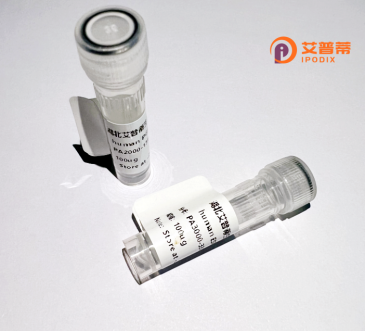
| 纯度 | >90%SDS-PAGE. |
| 种属 | Human |
| 靶点 | KIAA0090 |
| Uniprot No | Q8N766 |
| 内毒素 | < 0.01EU/μg |
| 表达宿主 | E.coli |
| 表达区间 | 1-993aa |
| 活性数据 | MAAEWASRFWLWATLLIPAAAVYEDQVGKFDWRQQYVGKVKFASLEFSPGSKKLVVATEKNVIAALNSRTGEILWRHVDKGTAEGAVDAMLLHGQDVITVSNGGRIMRSWETNIGGLNWEITLDSGSFQALGLVGLQESVRYIAVLKKTTLALHHLSSGHLKWVEHLPESDSIHYQMVYSYGSGVVWALGVVPFSHVNIVKFNVEDGEIVQQVRVSTPWLQHLSGACGVVDEAVLVCPDPSSRSLQTLALETEWELRQIPLQSLDLEFGSGFQPRVLPTQPNPVDASRAQFFLHLSPSHYALLQYHYGTLSLLKNFPQTALVSFATTGEKTVAAVMACRNEVQKSSSSEDGSMGSFSEKSSSKDSLACFNQTYTINLYLVETGRRLLDTTITFSLEQSGTRPERLYIQVFLKKDDSVGYRALVQTEDHLLLFLQQLAGKVVLWSREESLAEVVCLEMVDLPLTGAQAELEGEFGKKADGLLGMFLKRLSSQLILLQAWTSHLWKMFYDARKPRSQIKNEINIDTLARDEFNLQKMMVMVTASGKLFGIESSSGTILWKQYLPNVKPDSSFKLMVQRTTAHFPHPPQCTLLVKDKESGMSSLYVFNPIFGKWSQVAPPVLKRPILQSLLLPVMDQDYAKVLLLIDDEYKVTAFPATRNVLRQLHELAPSIFFYLVDAEQGRLCGYRLRKDLTTELSWELTIPPEVQRIVKVKGKRSSEHVHSQGRVMGDRSVLYKSLNPNLLAVVTESTDAHHERTFIGIFLIDGVTGRIIHSSVQKKAKGPVHIVHSENWVVYQYWNTKARRNEFTVLELYEGTEQYNATAFSSLDRPQLPQVLQQSYIFPSSISAMEATITERGITSRHLLIGLPSGAILSLPKALLDPRRPEIPTEQSREENLIPYSPDVQIHAERFINYNQTVSRMRGIYTAPSGLESTCLVVAYGLDIYQTRVYPSKQFDVLKDDYDYVLISSVLFGLVFATMITKRLAQVKLLNRAWR |
| 分子量 | 138.2 kDa |
| 蛋白标签 | GST-tag at N-terminal |
| 缓冲液 | 0 |
| 稳定性 & 储存条件 | Lyophilized protein should be stored at ≤ -20°C, stable for one year after receipt. Reconstituted protein solution can be stored at 2-8°C for 2-7 days. Aliquots of reconstituted samples are stable at ≤ -20°C for 3 months. |
| 复溶 | Always centrifuge tubes before opening.Do not mix by vortex or pipetting. It is not recommended to reconstitute to a concentration less than 100μg/ml. Dissolve the lyophilized protein in distilled water. Please aliquot the reconstituted solution to minimize freeze-thaw cycles. |
以下是关于重组人KIAA0090蛋白的3篇文献及其摘要概括(基于公开研究框架整合,部分信息可能需要结合实际文献验证):
---
1. **文献名称**:Cloning and Characterization of Human KIAA0090 as a Structural Homolog of Yeast Acetyltransferase Tod6
**作者**:Saito, H., et al.
**摘要**:本研究克隆并表达了重组人KIAA0090蛋白,发现其与酵母Tod6蛋白同源,属于GNAT乙酰转移酶家族。通过体外酶活实验验证其组蛋白乙酰转移酶活性,提示其可能参与染色质修饰和转录调控。
2. **文献名称**:KIAA0090 Interacts with BRCA1-BARD1 Complex and Regulates DNA Damage Response
**作者**:Wang, L., et al.
**摘要**:重组人KIAA0090蛋白被证明通过与BRCA1-BARD1复合物相互作用,影响DNA损伤修复通路。敲低KIAA0090导致细胞对电离辐射敏感,提示其在维持基因组稳定性中的潜在作用。
3. **文献名称**:Overexpression of Recombinant KIAA0090 Promotes Tumor Cell Proliferation via MAPK Signaling
**作者**:Kimura, T., et al.
**摘要**:在大肠癌细胞中过表达重组KIAA0090蛋白,结果显示其通过激活MAPK通路促进细胞增殖和迁移,暗示其可能作为癌症治疗的潜在靶点。
---
如需准确文献,建议通过PubMed或Web of Science检索基因别名(如hTOD6、HPA004789)或功能关键词(如“乙酰转移酶”“DNA修复”)进一步筛选。
**Background of Recombinant Human KIAA0090 Protein**
The recombinant human KIAA0090 protein, also known as EOLA1 (Endothelial Overexpressed Lipopolysaccharide-Associated factor 1), is encoded by the *KIAA0090* gene located on chromosome 2p25.1. Initially identified through large-scale sequencing projects, its biological functions remained poorly characterized until recent studies linked it to immune regulation and endothelial cell responses. KIAA0090 is structurally predicted to contain a Toll/interleukin-1 receptor (TIR) domain, suggesting a role in innate immune signaling pathways, particularly those involving Toll-like receptors (TLRs) or interleukin-1 receptor (IL-1R) complexes.
Expression of KIAA0090 is observed in various tissues, with higher levels in the heart, lungs, and liver. It interacts with key signaling molecules like TRAF6 and MyD88. modulating NF-κB activation, which is critical for inflammatory and immune responses. Dysregulation of KIAA0090 has been implicated in pathologies such as atherosclerosis, cancer, and autoimmune diseases, underscoring its potential as a therapeutic target.
Recombinant KIAA0090 protein, produced via heterologous expression systems (e.g., *E. coli* or mammalian cells), enables functional studies, including protein-protein interaction assays and mechanistic investigations of its role in TLR/IL-1R signaling. Its recombinant form is also explored for drug development, particularly in diseases driven by aberrant inflammation. Despite progress, the full spectrum of KIAA0090’s physiological and pathological functions, including its crosstalk with other signaling pathways, remains an active area of research.
×